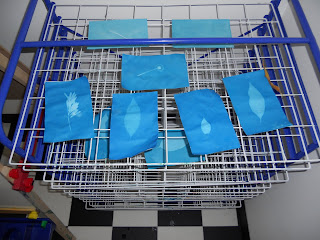 The children have been learning about the different parts of a plant, including the different structures present in leaves, and we have been discussing how plants make their own food through the process of photosynthesis. Photosynthesis begins when light is absorbed by proteins that contain chlorophyll (photons hit the chlorophyll and knock loose an electron) which begins an incredibly complex process in which energy from the sun is used to convert carbon dioxide into organic compounds (glucose) and oxygen. The ability of plants to perform this vital function can be traced back to cyano-bacteria (bluish green bacteria ) which were the very first plants on Earth, and responsible for making the oxygen that built up in the atmosphere to make life possible.
The children have been learning about the different parts of a plant, including the different structures present in leaves, and we have been discussing how plants make their own food through the process of photosynthesis. Photosynthesis begins when light is absorbed by proteins that contain chlorophyll (photons hit the chlorophyll and knock loose an electron) which begins an incredibly complex process in which energy from the sun is used to convert carbon dioxide into organic compounds (glucose) and oxygen. The ability of plants to perform this vital function can be traced back to cyano-bacteria (bluish green bacteria ) which were the very first plants on Earth, and responsible for making the oxygen that built up in the atmosphere to make life possible. Needless to say, it is difficult to comprehend how sunlight, carbon dioxide, and water can make carbohydrates and oxygen. Cyanotypes provide one opportunity for children to get a hands on, sensorial, experience with a photo-reactive chemical process and the opportunity to achieve a better understanding of chemical pigments by analogy.

The children select natural artifacts, place them on the photosensitive paper, and wait until three minutes has passed. They seemed very interested in the color transformation of the paper; additionally, many found watching the sand pass through the hourglass to be an exciting point of interest.

 Then the children develop their prints by rinsing them in water (where the unreacted, water-soluble, iron salts are washed away). We intensified the characteristic blue effect by adding some lemon juice to the water bath.
Then the children develop their prints by rinsing them in water (where the unreacted, water-soluble, iron salts are washed away). We intensified the characteristic blue effect by adding some lemon juice to the water bath.

I recommend supplementing the experience with an art appreciation lesson wherein you show the children some classic cyanotype prints; in particular, Anna Atkins, an English botanist and the first female photographer, has some very beautiful seaweed prints in her book Photographs of British Algae.
Older children can experiment with toning (changing the color of the print)- oolong tea works well! Also, here is something else that I plan to try (and present to the children if it is successful): http://www.alternativephotography.com/wp/processes/photsynthesis/photosynthesis-grow-your-own-photographic-supplies


No comments:
Post a Comment